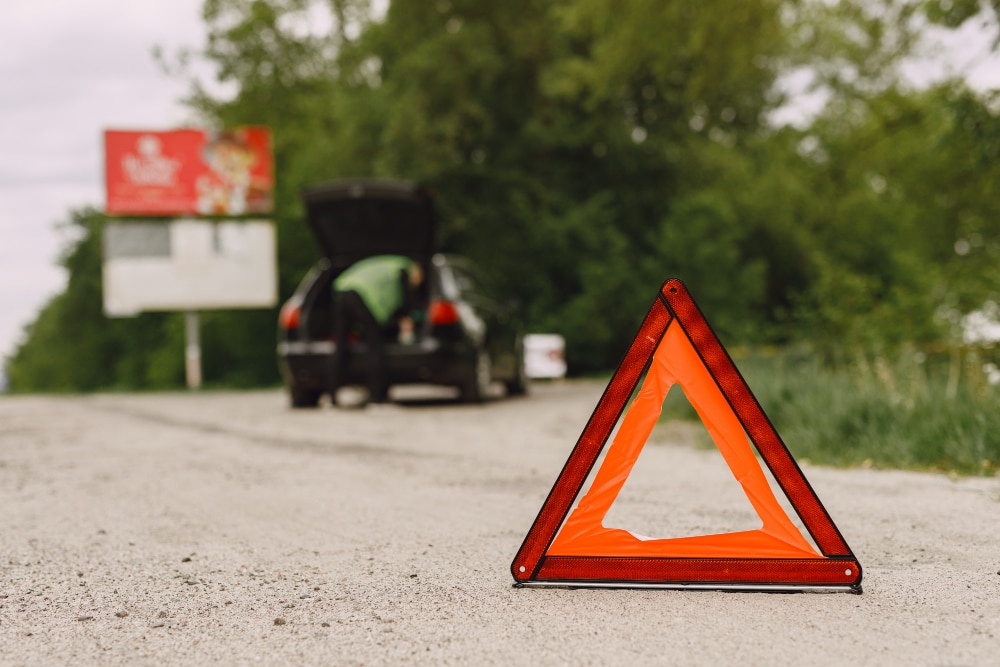Picture this: you’re cruising down the highway, enjoying a smooth drive with your favorite tunes playing in the background, when suddenly, your car starts acting up. Maybe it’s a flat tire, an overheated engine, or a sudden mechanical failure.

Or maybe it’s a car crash. Roadside emergencies can happen to anyone, and they often strike when you least expect it. In such moments, staying calm and collected is crucial for your safety and also for making sound decisions.
Here’s how to navigate through road emergencies effectively.
1. Assess the Situation Calmly
The first step in any emergency situation is to assess what’s happening. If your car starts acting up, take a deep breath and calmly observe the symptoms. Is the engine overheating? Is your tire flat? Use your turn signals to indicate that you’re slowing down and pull over to safety. Understanding the issue can help you decide on the best course of action.
If it’s a car crash, your approach may be different. Depending on the severity, you may need to leave the vehicle, crawl to safety, and call the emergency line for help. Whatever the case, your safety and that of any other passenger is paramount.
2. Call for Assistance if Possible
If you’re unable to resolve the issue yourself, it’s time to call your mechanic or available roadside assistance. Whether you’re a member of an auto club or have roadside assistance through your insurance, these services can help with towing, tire changes, jump-starts, and more.
But what if you’ve been hit by another driver? In such a case, don’t try to move the vehicle before calling the police and a car accident lawyer. Why? Everything counts! The police need a report of the accident, and you need an accident attorney to protect your rights if your injuries are a result of the other driver’s negligence, and you wish to pursue financial compensation or insurance coverage. Hence, it’s wise to have the contact information of the local emergency, lawyer as well as a mechanic for any potential emergency on the road.
3. Make Use of Your Emergency Kit
Every driver should carry an emergency kit in their vehicle. This kit should include essentials like a flashlight, batteries, reflective triangles or flares, a first-aid kit, basic tools, and a spare tire. If you have a flat tire and are in a safe location, you can change it yourself using the tools in your kit.
If you’re unsure how to do so, now is the time to consult your car’s manual or a reliable guide on changing tires. Again, if it’s an accident, you would need medical attention. And again, having the local emergency line is crucial. Whatever the case, having your emergency kit can still provide you with the basics to keep you safe and comfortable while you wait for help.
4. Stay Informed and Connected
While waiting for assistance, it’s important to stay informed and connected. Use your phone to check weather conditions and communicate with loved ones to let them know where you are and what’s happening. If you’re in an area with poor cell reception, move to a location with better signal strength or use a roadside emergency app.
If you’re traveling in an unfamiliar area, consider using a map app to pinpoint your location. This can be particularly useful when providing details to emergency services. If it’s an accident, don’t be in a rush to take the blame as the other driver may use your words against you if they decide to sue for damages.
5. Keep a Level Head
It’s natural to feel stressed or anxious during a roadside emergency, but keeping a level head is essential. Take deep breaths, focus on what you can control, and avoid making hasty decisions. If you’re traveling with others, reassure them and encourage everyone to remain calm.
If you’re driving with children, it’s especially important to stay composed. Kids can pick up on your stress, so try to maintain a positive attitude and keep them occupied with activities while you wait.
6. Reflect and Learn from the Experience
After the emergency is over and you’re safely back on the road, take some time to reflect on the experience. What went well? What could you have done differently? Use this as an opportunity to learn and better prepare for any future incidents.
Consider updating your emergency kit, learning more about basic car maintenance, or even taking a defensive driving course. The more prepared you are, the better you’ll handle unexpected situations on the road.
Conclusion
Roadside emergencies can be stressful and unpredictable, but staying calm and collected can help you navigate them safely and effectively. Always prioritize safety first above all, and call for help when necessary. Remember, preparation is key—so make sure you’re equipped with the tools and resources needed to handle emergencies.

